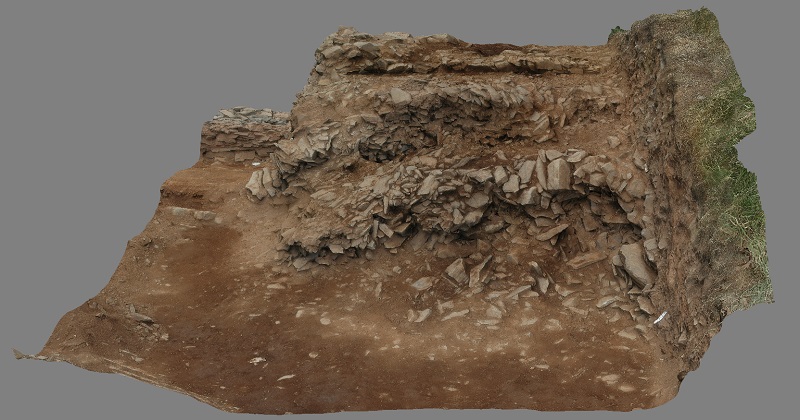Fortress from the Iron Age, Moel-y-Gaer Bodfari (Wales) - textured pattern that shows the structural sequences of the central bastion, by Gary Lock and John Pouncett
In addition to their expert eye, trained to ‘read’ the story of the remains found in the excavation, archaeologists today have technological ‘eyes’ available to them. Satellites, drones, as well as augmented reality and artificial intelligence are part of the archaeologist's ‘toolbox’.
But how can they use the potential of these new techniques to their utmost advantage? What are the results achieved thanks to the marriage of IT and archaeology? This is the topic of a new scientific journal, Journal of Computer Applications in Archaeology, supported by Computer Applications in Archaeology International (CAA), the biggest international organization that is made up of archaeologists, historians, art historians, mathematicians, statisticians, computer scientists, as well as experts in computer graphic, gaming, database, data mining and many other digital studies.
Launching the magazine in Atlanta a few days ago was Arianna Traviglia, one of the five members of the CAA executive, nominated co-editor of the magazine and Marie Curie fellow from the Department of Environmental Sciences, Informatics and Statistics at Ca’ Foscari.
What are the most surprising, innovative and curious examples of IT applied to archaeology?
“The choice is huge: from the 3D modelling of virtual or manufactured environments, to augmented reality; from simulations through models of past events to reconstructing ancient passages. However, one that has certainly started to emerge and that we will see grow in importance in future years is the use of artificial intelligence and Big Data. The possibilities, such as the use of huge quantities of archaeological information are endless, and this is made increasingly possible by the availability of “raw data” extracted from the research (whether from excavations or archaeological observations, or the study of artefacts through scientific approaches) available freely online that can be re-used by other scholars.”
When and how did the application of technology in this field arise?
“Although it may seem strange, the application of IT onto archaeology has been happening for nearly half a century. The CAA was founded 46 years ago in England by a small group of archaeologists and mathematicians interested in the study of the past in a different way. From this, the discipline evolved greatly and the archaeologists were among the firsts to adopt the computerization for the collection and management of data necessary for their own work. Further on, it was realized that Information Technology raised new questions. Today, all the main universities have digital archaeologists, working alongside traditional researchers.”
In the future will more archaeological discoveries be made behind a computer screen?
"The quantity of work developed at a computer will undoubtedly increase. Archaeologists are definitely already undertaking a lot of work ‘at the desk’ before starting an excavation, even if only to determine where it will occur. Without a doubt, the possibilities that the new technologies offer will allow us to carry out more analyses in support of the phases before and after going ‘on site’. The growth in sharing data of the work of one single team, furthermore, will be the basis of future discoveries.”
Why create a new journal specializing in IT and archaeology?
“Because it is about an area that has had an enormous expansion, but still does not have its own formal forum of discussion at global level. The objective of this new journal is to support a debate on the crucial role of IT in archaeology in the 21st Century and promote a careful use, from a theoretical point of view, of digital methods in archaeology. The journal is completely open access and includes a scrupolous double peer-review process. In less than two years we expect to reach a high Impact Factor and become extremely desirable for internationally renowned scholars".
Does it deal with methods as well as discoveries?
“The magazine deals with both of these, when the discoveries are made possible by the use of methods and technologies of Information Technology. Think, for example, about the development of satellite images to discover buried archaeological sites that are still unknown, or the use of geophysical tools that allow us to obtain a sort of 'x-ray' of the ground, providing, for example, a diagram of an entire buried structure without even having to dig. But new archaeological discoveries are also minuscule or almost invisible traces of engravings, or portraits on archaeological artefacts indistinguishable to the naked eye, and thus visible only on computer-manipulated images or via scans with computer vision techniques.”
What is the first issue about?
“The first issue of the journal (see the homepage below) contains mainly what we call ‘position papers’ , in other words, personal opinions written by the authors on a certain subject, in this case, regarding particular aspects of the field of archaeology, provided by the world’s leading experts in each area of research. The themes vary from the virtual reconstruction of ancient spaces, to the discoveries made possible through the development of images taken from space, from big data applied to archaeology to 3D modelling. All of these are illustrated by case studies of the most important archaeological sites in the world.

At what stage are we in the ‘fusion’ of the skills of IT specialists and archaeologists?
“In reality we can’t say whether there is or ever was a separation between the two figures. There were archaeologists who started to learn and experiment in a world that isn’t theirs. Nowadays, in many universities, the study of Archaeology and Information Technology already begins in the first years of university and has become an integral part of the figure of an archaeologist from the beginning, but I think that also, even those that have not had this type of training are now aware of the huge advantages of creation, management and development of data through computer systems.”










